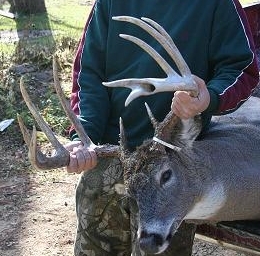 Have you ever seen a whitetail rack that has a hole in it similar to the one in this photo?
Have you ever seen a whitetail rack that has a hole in it similar to the one in this photo?
When Deer & Deer Hunting forum contributor Mark Schrock shared this photo of a buck he killed, the first thing I noticed was the hole in its main beam. These holes are actually quite common in the racks of mature deer. How does this happen?
Well, it can happen from various causes. The two most common causes for holes in antlers are via a burst blood vessel and through the work of parasites. Burst blood vessels are less common. Most holes you see in antlers are from the work of the botfly larvae, which starts as an internal parasite.
Parasites thrive easily on easily accessible food. That’s why it’s not unusual for a buck’s antlers to become the host of warbles (botflies). Botflies are any of a variety of stout-bodied, hairy dipterous flies of the families Oestridae and Gasterophilidae. The larvae are parasites of humans and cervids, like deer. According to Charles Alsheimer, and contrary to popular opinion, the botfly does not burrow into the velvet antler to lay its eggs. Instead, the parasite infects the host’s intestinal tract; where it incubates.
The parasite eventually makes its way through the bloodstream and, in the case of a white-tailed buck, eventually resides in the fast-growing velvet antler. The larvae feeds off of the nutrient rich bloodstream and burrows its way out of the antler before it hardens and peels, leaving behind a smooth cavity. Yes, it’s all kind of nasty and gross, but it doesn’t harm the deer — another testament to the amazing properties of whitetail antlers.
What about Mark’s buck? Well, that’s even more amazing. When Mark posted his photo, he wrote this: “This is my first buck! It scored 171 inches before deductions.”
That’s incredible, Mark. Way to go!
